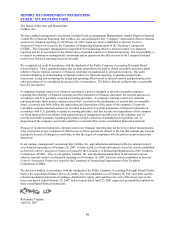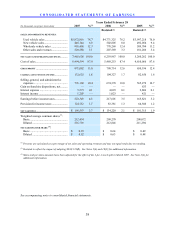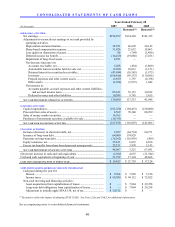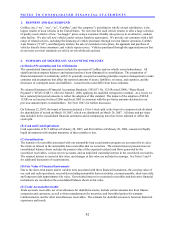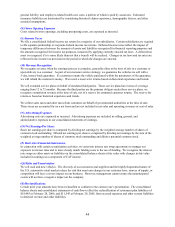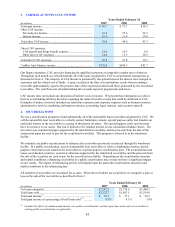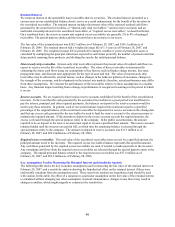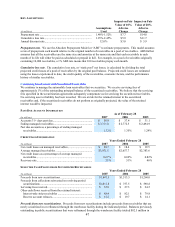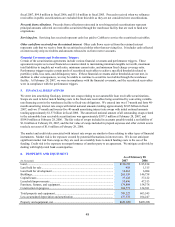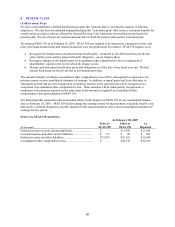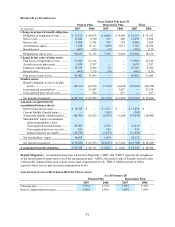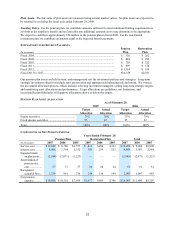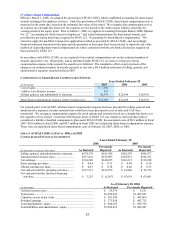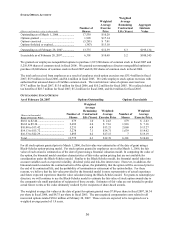CarMax 2007 Annual Report Download - page 56
Download and view the complete annual report
Please find page 56 of the 2007 CarMax annual report below. You can navigate through the pages in the report by either clicking on the pages listed below, or by using the keyword search tool below to find specific information within the annual report.46
Retained Interest
We retain an interest in the automobile loan receivables that we securitize. The retained interest, presented as a
current asset on our consolidated balance sheets, serves as a credit enhancement for the benefit of the investors in
the securitized receivables. The retained interest includes the present value of the expected residual cash flows
generated by the securitized receivables, or “interest-only strip receivables,” various reserve accounts, and an
undivided ownership interest in the securitized receivables, or “required excess receivables,” as described below.
On a combined basis, the reserve accounts and required excess receivables are generally 2% to 4% of managed
receivables. The special purpose entities and the investors have no recourse to our assets.
The fair value of the retained interest was $202.3 million as of February 28, 2007, and $158.3 million as of
February 28, 2006. The retained interest had a weighted average life of 1.5 years as of February 28, 2007, and
February 28, 2006. The weighted average life in periods (for example, months or years) of prepayable assets is
calculated by multiplying the principal collections expected in each future period by the number of periods until that
future period, summing those products, and dividing the sum by the initial principal balance.
Interest-only strip receivables. Interest-only strip receivables represent the present value of residual cash flows we
expect to receive over the life of the securitized receivables. The value of these receivables is determined by
estimating the future cash flows using our assumptions of key factors, such as finance charge income, loss rates,
prepayment rates, and discount rates appropriate for the type of asset and risk. The value of interest-only strip
receivables may be affected by external factors, such as changes in the behavior patterns of customers, changes in
the strength of the economy, and developments in the interest rate markets; therefore, actual performance may differ
from these assumptions. We evaluate the performance of the receivables relative to these assumptions on a regular
basis. Any financial impact resulting from a change in performance is recognized in earnings in the period in which
it occurs.
Reserve accounts. We are required to fund various reserve accounts established for the benefit of the securitization
investors. In the event that the cash generated by the securitized receivables in a given period was insufficient to
pay the interest, principal, and other required payments, the balances on deposit in the reserve accounts would be
used to pay those amounts. In general, each of our securitizations requires that an amount equal to a specified
percentage of the original balance of the securitized receivables be deposited in a reserve account on the closing date
and that any excess cash generated by the receivables be used to fund the reserve account to the extent necessary to
maintain the required amount. If the amount on deposit in the reserve account exceeds the required amount, the
excess is released through the special purpose entity to the company. In the public securitizations, the amount
required to be on deposit in the reserve account must equal or exceed a specified floor amount. The reserve account
remains funded until the investors are paid in full, at which time the remaining balance is released through the
special purpose entity to the company. The amount on deposit in reserve accounts was $31.5 million as of
February 28, 2007, and $29.0 million as of February 28, 2006.
Required excess receivables. The total value of the securitized receivables must exceed, by a specified amount, the
principal amount owed to the investors. The required excess receivables balance represents this specified amount.
Any cash flows generated by the required excess receivables are used, if needed, to make payments to the investors.
Any remaining cash flows from the required excess receivables are released through the special purpose entity to the
company. The unpaid principal balance related to the required excess receivables was $57.0 million as of
February 28, 2007, and $52.2 million as of February 28, 2006.
Key Assumptions Used in Measuring the Retained Interest and Sensitivity Analysis
The following table shows the key economic assumptions used in measuring the fair value of the retained interest at
February 28, 2007, and a sensitivity analysis showing the hypothetical effect on the retained interest if there were
unfavorable variations from the assumptions used. These sensitivity analyses are hypothetical and should be used
with caution. In this table, the effect of a variation in a particular assumption on the fair value of the retained interest
is calculated without changing any other assumption; in actual circumstances, changes in one factor may result in
changes in another, which might magnify or counteract the sensitivities.


